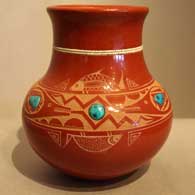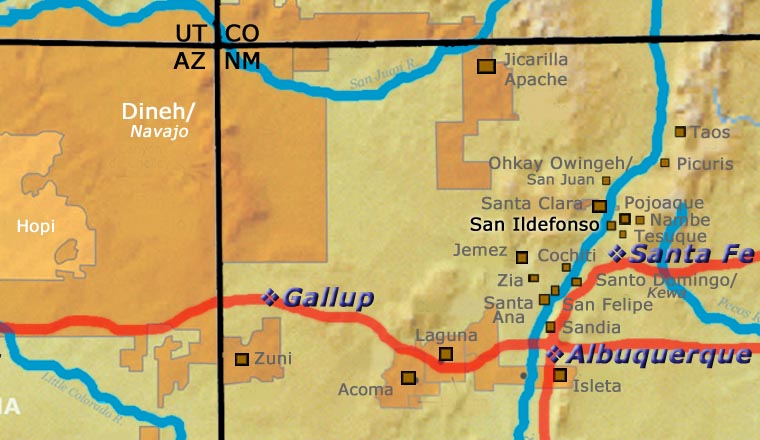
Tony Da
1940-2008
San Ildefonso

Tony Da was the son of Popovi Da and grandson of Maria Martinez. He grew up surrounded by some of the finest potters and painters at San Ildefonso Pueblo and his early education emphasized those traditional arts. He lived with his grandmother Maria while his father was in the Army during World War II and she felt great promise in him as an artist. When he started school, though, it was quickly felt that he was most likely dyslexic. After finishing his first eight years in the Pojoaque Valley schools, he moved on to St. Michael's High School in Santa Fe. He was unhappy there and transferred to Santa Fe High where he graduated in 1958. He then attended Western New Mexico College (in Silver City) for a year before joining the US Navy for four years. It was at Western New Mexico that he was exposed to Mimbres pottery and its imagery and that made a life-long impression on him. It was also at Western New Mexico that he was exposed to modern methods of painting and ceramics production.
When he returned to San Ildefonso in 1964 he became fascinated with the pottery that his grandmother and father were creating together. At that time he apprenticed himself to Maria and began learning to make pottery in earnest. His progress was such that three years later his works appeared alongside Maria's and Popovi's in the Three Generations Show at the US Department of the Interior in Washington, DC. In 1967 he also had his first booth at the Gallup InterTribal Ceremonials. He took eight pieces of his art to the show and earned four First Place ribbons and one Second Place ribbon for pottery, two more First Place ribbons in painting and one more in sculpture. One of his paintings and one of his pots also received "Excellent" ribbons.
Tony didn't produce a lot of pottery during his short career and he mainly produced redware, blackware and two-tone bowls, plates, jars, turtles and bears. His favorite designs seem to have been kokopelli, avanyu (water serpent), buffalo, bear and cloud, sometimes painted and sometimes etched (sgraffito).
Tony was able to build something new on the foundation of his family, who had built something new on the foundation of their predecessors. His work has been called inspired and innovative and it has made an enormous impact on modern pueblo ceramics, especially at San Ildefonso and Santa Clara. Tony was the first Pueblo potter to inlay strands of heishi, coral and turquoise beads, often in incised channels around the tall necks of vases. He also painted and incised designs found on ancient Mimbres pottery. In the late 1960s he was developing low relief sgraffito designs. He also became famous for his two-tone pottery bear fetishes, often wrapped and inlaid with channel beading. He participated in the Santa Fe Indian Market between 1967 and 1976, earning several First Place ribbons for his pottery.
In an interview in 1971 Tony said, "If my work is satisfactory to me then I am content. I do it mostly for my own pleasure." He also famously said, "I'm not really influenced by current trends. I do what I like. I learned pottery making from my grandmother but I have never had any lessons in painting. That is all self-taught. I use a lot of drafting in my paintings and the style is the same. A crooked line bothers me. I can't make a crooked line."
On April 15, 1982, Tony had a motorcycle accident on a gravel road that caused a severe brain injury. It didn't end his life but it ended his pottery-making career. He was able to continue painting but his creations were much simpler and didn't have the depth of field of his previous work. Like his father before him, he was a perfectionist and he'd felt he was about to make an extraordinary breakthrough in his work before the accident. Who knows what he might have achieved had he been wearing a helmet that fateful day.
Tony Da's influence has been such that The Life and Art of Tony Da was first published in 2011 and passed through ten printings very quickly. That same year the Museum of Indian Arts and Culture in Santa Fe opened Creative Spark! The Life and Art of Tony Da, the largest and most comprehensive showing ever of Tony Da paintings and pottery. Some of the works shown had never been seen in public before.
Tony's wife Lou died before he did. His son Jarrod Da is a renowned painter who is forging into new areas in Native American painting while Tony's daughter Royale Da is a news anchor with one of the network television stations in Albuquerque.
100 West San Francisco Street, Santa Fe, New Mexico 87501
(505) 986-1234 - www.andreafisherpottery.com - All Rights Reserved

San Ildefonso Pueblo
San Ildefonso Pueblo is located about twenty miles northwest of Santa Fe, New Mexico, west of Pojoaque, south of Santa Clara and straddling the Rio Grande. Although their ancestry has been traced to prehistoric pueblos in the Greater Mesa Verde area, the prehistoric pueblo at Tsankawi, in a non-contiguous parcel of Bandelier National Monument, is their most recent ancestral home. Tsankawi abuts the reservation on its northwest side.
Franciscan monks named the village after San Ildefonso and in 1617, forced the tribe to build a mission church on top of the village's main kiva. Before that the village was known as Powhoge, "where the water cuts through" (in Tewa). Today's pueblo was established as long ago as the 1300s. When the Spanish arrived in 1540, they estimated the village population at about 2,000.
That mission was destroyed during the Pueblo Revolt of 1680 and when Don Diego de Vargas returned to reclaim San Ildefonso in 1694, he found virtually all the Tewa people camped out on top of nearby Black Mesa. After an extended siege the two sides negotiated a treaty and the people returned to their villages. However, the next 250 years were not so good for them.
The swine flu pandemic of 1918 reduced the pueblo's population to about 90. Their population has grown to more than 600 since but the only economic activity available on the pueblo itself involves creating art in one form or another. The only other work is off-pueblo. San Ildefonso's population is small compared to neighboring Santa Clara Pueblo, but the pueblo maintains its own religious traditions and ceremonial feast days.
San Ildefonso is most known for being the home of the most famous Pueblo Indian potter, Maria Martinez. Many other excellent potters from this pueblo have produced quality pottery, too, among them: Blue Corn, Tonita and Juan Roybal, Dora Tse Pe and Rose Gonzales. Of course, the descendants of Maria Martinez are still important pillars of San Ildefonso's pottery tradition. Maria's influence reached far and wide, so far and wide that even Juan Quezada of the Mata Ortiz pottery renaissance in Chihuahua, Mexico, came to San Ildefonso to learn from her.
100 West San Francisco Street, Santa Fe, New Mexico 87501
(505) 986-1234 - www.andreafisherpottery.com - All Rights Reserved

